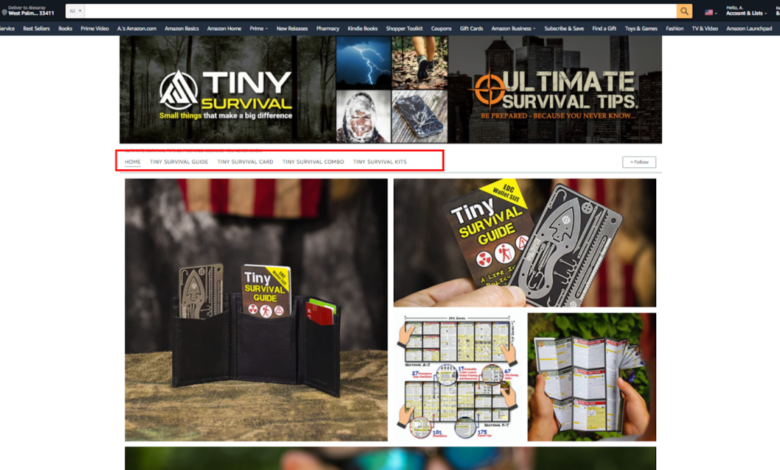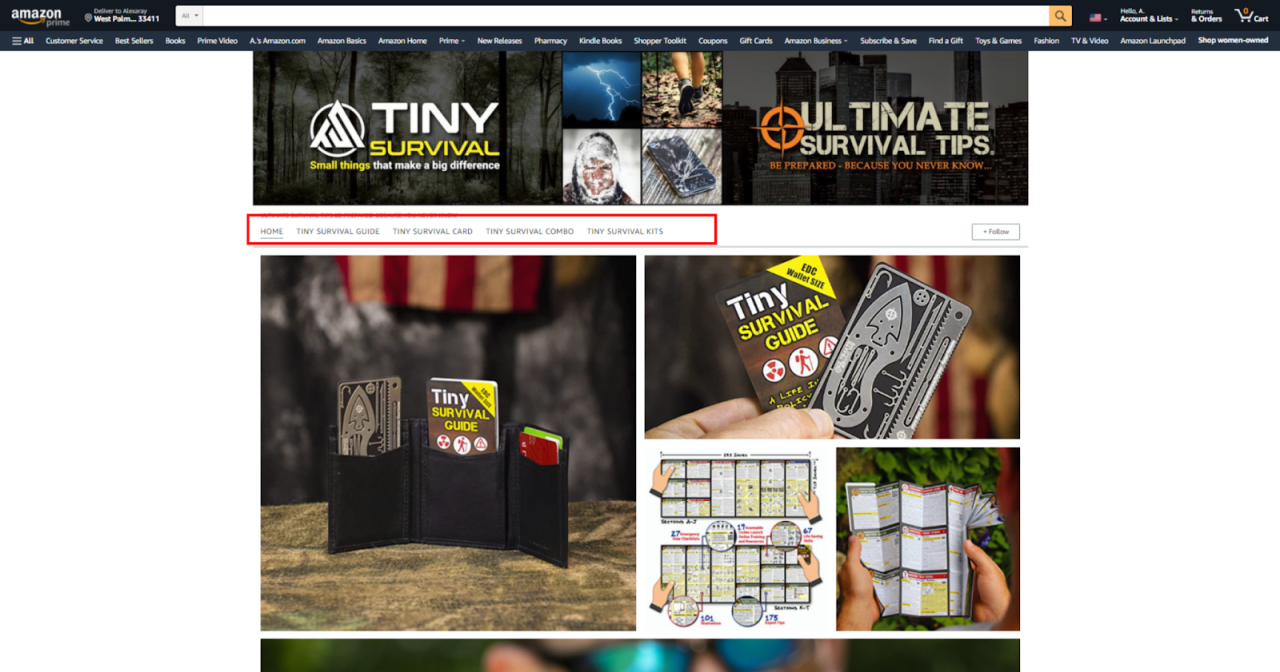
Amazon Storefront 101 Your Guide to Success
Amazon Storefront 101 is your comprehensive guide to mastering your online presence on the world’s largest e-commerce platform. From crafting a captivating storefront design to optimizing product listings and driving sales, this guide will equip you with the essential knowledge to thrive in the competitive Amazon marketplace.
We’ll explore everything from the fundamentals of setting up your Amazon storefront to advanced strategies for boosting visibility and engagement. Discover the secrets to creating a visually appealing storefront, showcasing your products effectively, and fostering strong customer relationships that lead to increased sales.
Introduction to Amazon Storefront
An Amazon storefront is a personalized online shop within the Amazon marketplace, allowing sellers to showcase their products and manage their sales directly on the Amazon platform. It’s essentially a curated selection of products, presented in a user-friendly way to attract customers and increase sales visibility. This distinct storefront, compared to simply listing items on the general Amazon marketplace, offers significant advantages for sellers looking to brand and promote their goods.The purpose of an Amazon storefront is to provide a dedicated space for a seller to highlight their brand, products, and overall business identity.
It’s a controlled environment where sellers can better organize and present their inventory, fostering a more engaging customer experience and encouraging higher sales conversion rates. This focused approach often enhances customer trust and recognition of the seller’s brand, which in turn can lead to better sales performance.
Key Features of an Amazon Storefront
Amazon storefronts differ from simple product listings on the main marketplace through several key characteristics. These distinguishing features help sellers manage their brand image and product visibility more effectively.
- Branding and Customization: Storefronts enable sellers to establish a unique brand identity. This includes custom logos, branding colors, and a consistent product presentation. This visual consistency strengthens the brand perception and attracts customers who are already familiar with the brand or looking for a particular aesthetic.
- Enhanced Product Organization: Sellers can organize their products into categories, collections, or themed displays. This allows customers to easily browse items related to specific interests or needs. For example, a clothing retailer can organize their items into categories like “Fall Fashion” or “Men’s Sweaters,” facilitating easier browsing.
- Improved Customer Experience: Storefronts often include detailed product descriptions, high-quality images, and customer reviews, creating a more engaging and trustworthy shopping experience. This feature helps build trust and confidence in the seller and their products, which is crucial in online commerce.
- Targeted Promotions and Sales: Storefronts allow for the implementation of targeted promotions and special offers. This feature can increase sales by drawing attention to specific products or creating a sense of urgency for customers.
Examples of Successful Amazon Storefronts
Several businesses have successfully leveraged Amazon storefronts to achieve significant growth. These examples showcase the power of a well-designed storefront to attract and retain customers.
- Established Brands with Strong Online Presence: Many well-known brands use Amazon storefronts to expand their reach and offer a more streamlined shopping experience for customers already familiar with their products. The storefront enhances the shopping experience and presents a consistent brand identity.
- New Businesses Targeting Niche Markets: Startups and businesses focusing on specialized products can leverage storefronts to showcase their unique offerings and attract customers seeking those particular goods. A specific niche will attract a specific group of consumers.
Comparison of Amazon Storefront Features with Other Platforms
The following table compares key features of Amazon storefronts with other popular e-commerce platforms, highlighting the unique advantages of an Amazon storefront.
| Feature | Amazon Storefront | Shopify | Etsy |
|---|---|---|---|
| Branding Customization | High – extensive branding options | Moderate – strong branding capabilities | Moderate – good for specific niches |
| Product Organization | Good – categories, collections | Good – themes, collections | Good – by shop or craft |
| Customer Reviews & Feedback | Integrated with Amazon platform | Platform-based system | Integrated with platform |
| Pricing & Promotions | Subject to Amazon policies | Flexible pricing controls | Pricing determined by sellers |
Setting Up Your Amazon Storefront: Amazon Storefront 101

Creating a compelling Amazon storefront is crucial for attracting customers and driving sales. A well-designed storefront, showcasing your products effectively, can significantly impact your visibility and overall success on the platform. This guide will walk you through the essential steps involved in building a professional and engaging storefront.Amazon storefronts offer a customizable space beyond the standard product listings. They provide a dedicated area for showcasing your brand, products, and unique selling propositions, leading to increased customer engagement and potentially higher conversion rates.
Understanding the key elements and steps involved in setting up your Amazon storefront is vital for maximizing its potential.
Steps to Creating Your Amazon Storefront
Setting up your Amazon storefront involves a series of straightforward steps. Each step is crucial in building a strong online presence.
- Create Your Storefront: Start by accessing your Amazon Seller Central account. Navigate to the Storefront section and follow the prompts to create a new storefront. This initial setup will establish the foundation for your visual presentation. Pay close attention to the storefront’s available templates and customization options.
- Design Your Storefront: A visually appealing storefront is essential. Choose a design that aligns with your brand identity and target audience. Employ high-quality images and concise, compelling text to effectively communicate your value proposition. Consider the color scheme and overall layout to create a consistent brand image across your entire storefront.
- Organize Product Listings: Organize your product listings within the storefront. Categorize them logically, using clear and concise descriptions, high-quality images, and compelling product titles. Ensure your listings are optimized for search engines and highlight unique selling points.
- Add Product Highlights: Showcase key product features and benefits to attract customers. Utilize features like video demonstrations, customer testimonials, and detailed product descriptions to increase customer confidence and drive conversions.
- Implement Calls to Action: Include clear calls to action within your storefront. Encourage customers to explore your products further by using prominent buttons, compelling language, and strategically placed links.
- Test and Refine: Regularly analyze your storefront’s performance. Track key metrics like visitor engagement, conversion rates, and sales data. Use this data to identify areas for improvement and refine your storefront design for optimal results.
Importance of Compelling Storefront Design
A well-designed storefront acts as a virtual storefront window, attracting customers and communicating your brand’s personality. It’s an essential tool for standing out in the competitive Amazon marketplace. A compelling design, including high-quality images and user-friendly navigation, can significantly increase customer engagement and lead to higher conversion rates.
Significance of Product Listings
Product listings within your storefront are crucial for conveying essential product information to potential customers. Detailed, accurate, and well-presented listings are vital for attracting customers and ultimately driving sales. High-quality images, compelling descriptions, and accurate product information are essential for successful product listings.
| Step | Action | Description |
|---|---|---|
| 1 | Create Storefront | Access Seller Central, navigate to Storefront, and initiate creation. |
| 2 | Design Storefront | Select a design aligning with brand identity, use high-quality images, and clear concise text. |
| 3 | Organize Product Listings | Categorize products logically, using compelling descriptions and high-quality images. |
| 4 | Add Product Highlights | Showcase key features and benefits using videos, testimonials, and detailed descriptions. |
| 5 | Implement Calls to Action | Use clear calls to action to encourage exploration and purchases. |
| 6 | Test and Refine | Monitor performance metrics, identify areas for improvement, and optimize the design for better results. |
Optimizing Your Storefront
A well-optimized Amazon storefront is crucial for attracting customers and driving sales. Beyond simply setting up your storefront, understanding how to maximize its visibility and appeal is key to success. This section delves into strategies to enhance visibility, optimize product listings, create a user-friendly experience, and boost customer engagement.Effective storefront optimization is a continuous process that involves adapting to changes in Amazon’s algorithms and customer preferences.
Regularly analyzing performance data and making adjustments to your approach will yield the best results.
Enhancing Storefront Visibility
Understanding how your storefront appears in search results is paramount. Amazon’s search algorithm considers various factors, including storefront s, product listings, and overall customer experience. Optimizing your storefront’s appearance across these areas will increase its visibility to potential customers. This involves ensuring clear and concise product descriptions and highlighting key features. Implementing compelling visuals, such as high-quality product images, can also significantly improve visibility.
Optimizing Product Listings for Search
Comprehensive and accurate product listings are critical for search engine optimization (). Using relevant s throughout the description, title, and bullet points is essential for improved search ranking. Incorporating specific s, long-tail s, and phrases that potential customers are likely to use in their searches is vital. High-quality product images and detailed descriptions that highlight key features and benefits will also increase visibility and customer engagement.
Thorough research into customer search queries can guide the selection of effective s.
Elements Contributing to a User-Friendly Storefront
A user-friendly storefront enhances the customer experience, leading to increased engagement and conversions. Clear navigation, easy-to-read product descriptions, and visually appealing layouts are crucial. Customers should be able to quickly and easily find the products they are looking for. A visually appealing storefront, with high-quality images and clear product information, fosters trust and encourages purchases. Ensuring quick page load times and responsive design across different devices is also critical.
Improving Customer Engagement on Your Storefront, Amazon storefront 101
Engaging customers on your storefront is essential for driving conversions. Implementing interactive elements, such as customer reviews and ratings, can foster trust and encourage purchases. Highlighting customer testimonials and successful case studies can also build confidence in your products and services. Using calls to action (CTAs) to encourage specific actions, such as purchasing or adding products to a wishlist, can drive conversions.
Implementing clear and concise information about return policies and shipping options can also enhance customer engagement.
So, you’re diving into Amazon storefront 101? It’s all about showcasing your products effectively, and understanding the nuances of the platform is key. Recent insights from Dara Treseder, CMO at Peloton (check out her recognition as Ignite Marketer of the Week here ), highlight the importance of targeted marketing strategies within the Amazon ecosystem. Ultimately, a strong Amazon storefront translates into better visibility and sales, so keep learning and experimenting!
Strategies Comparison Table
| Strategy | Description | Benefits | Potential Drawbacks |
|---|---|---|---|
| Search Engine Optimization () | Optimizing product listings and storefront content for improved search ranking. | Increased organic traffic, cost-effective long-term strategy. | Results can take time to appear, requires ongoing effort. |
| Paid Advertising (e.g., Amazon Ads) | Using paid advertising campaigns to increase storefront visibility and product exposure. | Faster results, targeted campaigns, greater control over exposure. | Requires budget allocation, potential for wasted spend if not managed effectively. |
| Customer Reviews and Testimonials | Displaying and encouraging customer reviews and testimonials. | Builds trust, enhances social proof, influences purchasing decisions. | Requires effort to gather and manage reviews, some negative reviews are unavoidable. |
Product Presentation
A compelling product presentation is crucial for attracting customers and driving sales on Amazon. Effective presentation goes beyond simply listing features; it involves crafting a narrative that highlights the value proposition of your product. By showcasing the product’s benefits and visual appeal, you can significantly increase your chances of converting browsers into buyers.High-quality images and videos, coupled with detailed, engaging descriptions, are fundamental components of a winning product presentation strategy.
So, you’re diving into Amazon storefront 101? Great! Understanding how to effectively present your products on the platform is key. To maximize your reach, consider integrating email marketing into your strategy. A solid email marketing platform like HubSpot can significantly boost sales. For a comprehensive review of the HubSpot email marketing platform, check out this insightful piece: review hubspot email marketing platform.
Ultimately, mastering the intricacies of Amazon’s storefront will require a multifaceted approach, and integrating tools like HubSpot email marketing is a powerful strategy to consider.
These elements collectively create a holistic experience that resonates with potential customers, encouraging them to explore your product further and ultimately make a purchase.
High-Quality Images and Videos
High-quality visuals are paramount for attracting attention and building trust. Customers often make initial judgments based on visual appeal. Clear, well-lit images and videos are essential for showcasing the product’s features and benefits effectively. Product images should ideally capture the product from various angles, highlighting its design, materials, and functionality. Videos can further demonstrate the product’s usage, performance, or unique selling points.
Consider including a 360-degree view if applicable, allowing customers to examine the product from all perspectives.
Compelling Product Descriptions
Detailed and compelling descriptions are vital for conveying the product’s value proposition beyond its visual aspects. Descriptions should not only list features but also explain how these features translate into benefits for the customer. Use evocative language and address customer needs and pain points. Clearly articulate the product’s advantages, emphasizing its unique selling points. Avoid jargon and technical terms unless absolutely necessary, and instead use simple, straightforward language.
Employ bullet points or short paragraphs to make the description easy to read and scan.
Highlighting Product Features and Benefits
Effective product presentation hinges on highlighting the tangible advantages of your product. Instead of simply listing features, connect each feature to a specific benefit for the customer. This approach helps customers understand the value proposition and why they should choose your product over competitors. A strong feature-benefit analysis will create a clear understanding of how the product solves a problem or improves the customer’s life.
Product Feature-Benefit Table
| Product Feature | Benefit | Visual Representation |
|---|---|---|
| Durable, scratch-resistant finish | Long-lasting product that maintains its appearance over time | Images showing the product being dropped or scratched with minimal damage, close-ups highlighting the finish’s texture |
| Lightweight design | Easy portability and comfortable handling | Images and videos demonstrating the product being used by a person, emphasizing the lightness and ease of handling. |
| Smart temperature control | Precise temperature adjustments for optimal cooking/heating results | Videos showcasing the product’s digital interface and the different temperature settings in action. |
| Water-resistant material | Safe use in wet or humid environments | Images showing the product submerged in water or used in a humid environment with no visible damage. |
Customer Engagement
Engaging customers on your Amazon storefront is crucial for driving sales and building brand loyalty. A well-designed storefront, while visually appealing, is only half the battle. Active customer engagement fosters trust and encourages repeat business. This section will explore strategies to effectively interact with your customers and build lasting relationships.Customer engagement on Amazon goes beyond simply listing products.
It’s about actively fostering relationships, addressing concerns, and showcasing your brand’s personality. Building a community around your products is vital for long-term success.
Strategies for Engaging Customers
Effective customer engagement strategies are key to driving sales and creating a positive brand image. These strategies go beyond just listing products, focusing on fostering a sense of community and trust.
- Personalized Recommendations: Tailored recommendations based on customer browsing history and purchase patterns can significantly improve the customer experience. This approach increases the likelihood of a purchase by presenting relevant products to the customer. For example, if a customer frequently buys gardening tools, suggesting related accessories or complementary plants can lead to higher conversion rates.
- Interactive Content: Incorporating interactive elements like product demos, videos, and customer testimonials can enhance engagement and trust. These elements offer a dynamic presentation, going beyond static product descriptions.
- Live Q&A Sessions: Conducting live Q&A sessions with experts or company representatives allows customers to get immediate answers to their questions. This personalized approach builds trust and addresses customer concerns in real-time. This is particularly useful for complex products or those with specific technical requirements.
Encouraging Customer Reviews and Feedback
Positive customer reviews significantly influence purchasing decisions. Actively encouraging and responding to reviews builds trust and showcases the value of your products.
- Incentivize Reviews: Offering incentives like discounts or exclusive access to new products can motivate customers to leave reviews. This can include small discounts for reviewing a product or early access to sales.
- Prompt for Reviews: Strategically place prompts to request reviews within the customer journey. This could be a follow-up email after a purchase or a notification on the product page. This direct approach encourages customers to share their experiences.
- Respond to Reviews: Addressing both positive and negative reviews demonstrates your commitment to customer satisfaction. Thank customers for positive feedback and address concerns raised in negative reviews professionally and promptly.
Building Customer Relationships
Cultivating customer relationships fosters loyalty and repeat business. This involves understanding customer needs and preferences.
- Email Marketing: Use email marketing to nurture customer relationships by sharing product updates, promotions, and exclusive content. This maintains engagement and provides valuable information.
- Social Media Engagement: Actively engage with customers on social media platforms. Respond to comments and questions, and participate in relevant conversations. Social media is an excellent channel for building brand loyalty and addressing customer concerns.
- Loyalty Programs: Implement loyalty programs to reward repeat customers and incentivize repeat purchases. Offering exclusive discounts or early access to new products fosters a sense of appreciation and encourages repeat business.
Responding to Customer Inquiries
Efficiently responding to customer inquiries is essential for maintaining a positive customer experience. This involves providing accurate and timely information.
- Prompt Responses: Establish a system for quickly responding to customer inquiries. This could involve using an automated system or a dedicated team. Prompt responses are essential for maintaining a positive customer experience.
- Clear Communication: Ensure all communications are clear, concise, and easy to understand. Use simple language and avoid jargon. Clear communication fosters trust and understanding.
- Tracking Inquiries: Track customer inquiries to ensure all issues are resolved. This helps identify patterns and areas for improvement.
Using Q&A Sections to Enhance Customer Interaction
Utilizing Q&A sections allows customers to access readily available information. This enhances interaction and builds trust.
- Encourage Questions: Encourage customers to ask questions about your products or services by highlighting the Q&A section. This prompts customers to engage with the information available.
- Thorough Answers: Provide comprehensive and accurate answers to customer questions. Avoid vague or generic responses. Thorough answers showcase expertise and build trust.
- Regular Updates: Regularly update the Q&A section with new questions and answers to ensure it remains a valuable resource. Maintaining the Q&A section demonstrates a commitment to providing helpful information.
Driving Sales

Turning your Amazon storefront into a sales powerhouse requires a multi-faceted approach. Simply showcasing products isn’t enough; you need strategies to encourage customers to not just view but purchase. This section delves into proven techniques for boosting conversions, optimizing pricing, fostering trust, and ultimately, driving sales.
Strategies for Increasing Sales Conversions
Effective conversion strategies are crucial for turning website visitors into paying customers. These strategies go beyond simply listing products; they involve understanding customer behavior and tailoring your storefront to meet their needs. A well-structured storefront with clear calls to action, high-quality product images, and detailed descriptions can significantly increase the likelihood of a sale.
- Clear Call-to-Action (CTA) Buttons: Strategically placed and visually appealing CTAs, such as “Add to Cart,” “Buy Now,” or “Learn More,” guide visitors through the purchasing process. Using compelling language and colors further enhances their effectiveness. Examples include prominent “Buy Now” buttons on product pages or “Shop the Collection” buttons for related products.
- High-Quality Product Images and Videos: Visually appealing product representations are crucial. Clear, high-resolution images showcasing various angles and details significantly enhance product understanding and reduce the risk of returns due to discrepancies between the product and the customer’s expectations. Videos demonstrating product use or showcasing features can be even more persuasive.
- Compelling Product Descriptions: Detailed and engaging descriptions that highlight key features, benefits, and customer testimonials foster trust and understanding. Focus on addressing customer needs and motivations. Include relevant s to improve search visibility.
- Customer Reviews and Testimonials: Positive customer reviews and testimonials significantly boost trust. Displaying genuine customer feedback builds credibility and encourages others to make purchases.
The Role of Pricing and Promotions in Driving Sales
Pricing and promotions are essential tools for attracting customers and driving sales. Understanding the nuances of both is crucial for achieving optimal results. Strategic pricing decisions and well-timed promotions can significantly impact conversion rates and overall revenue.
- Competitive Pricing Strategies: Researching competitor pricing and analyzing market trends allows you to set competitive prices that attract customers without sacrificing profitability. This involves analyzing competitor pricing, understanding the market, and calculating your own costs to achieve optimal pricing.
- Promotional Strategies: Promotions like discounts, coupons, bundles, and free shipping can entice customers to make a purchase. Effective promotional strategies can incentivize customers to make immediate purchases and encourage repeat business.
- Pricing Psychology: Understanding how customers perceive prices can influence your pricing strategy. Strategies like using price anchoring, price rounding, and highlighting value propositions can effectively impact customer perception and decision-making.
Methods to Enhance Customer Trust and Confidence
Building customer trust is essential for long-term success. Trust-building methods help establish a positive brand image and encourage repeat business. Clear communication, transparency, and prompt responses to customer inquiries are crucial.
- Transparency in Product Information: Detailed and accurate product descriptions, including specifications, materials, and potential drawbacks, build customer trust. Avoid misleading or vague descriptions that could create doubt or dissatisfaction.
- Secure Payment Processing: Implementing secure payment gateways and displaying trust badges, such as the Amazon Pay logo or other recognized security symbols, reassure customers about the safety of transactions.
- Prompt and Helpful Customer Service: Providing quick and helpful responses to customer inquiries, resolving issues promptly, and addressing concerns effectively fosters trust and positive experiences.
Elements that Encourage Customers to Make Purchases
Various elements contribute to a compelling buying experience, ultimately encouraging customers to make purchases. Understanding these elements and incorporating them into your storefront design is key to maximizing conversions.
- Easy Navigation and User-Friendly Design: A well-organized storefront with clear navigation ensures a positive customer experience. Ease of use and intuitive design elements improve the customer journey.
- High-Quality Product Packaging: Protective and appealing packaging contributes to the overall customer experience and protects the product during transit, creating a positive first impression.
- Positive Customer Reviews and Testimonials: Customer feedback plays a significant role in building trust and influencing purchasing decisions. Displaying positive reviews and testimonials builds confidence in the product and brand.
Pricing Strategies, Promotion Types, and Customer Trust-Building Methods
This table Artikels key strategies for enhancing sales conversions, considering pricing, promotions, and trust-building methods.
| Pricing Strategies | Promotion Types | Customer Trust-Building Methods |
|---|---|---|
| Competitive Pricing, Value-Based Pricing, Premium Pricing | Discounts, Coupons, Bundles, Free Shipping, Flash Sales | Detailed Product Descriptions, Secure Payment Gateways, Customer Reviews, Responsive Customer Service |
Analytics and Reporting
Understanding your Amazon storefront’s performance is crucial for success. Data-driven insights allow you to identify strengths, pinpoint areas needing improvement, and ultimately, boost sales and customer satisfaction. This section delves into the world of Amazon storefront analytics, highlighting key metrics and strategies for using data to optimize your presence.Amazon provides robust tools for tracking storefront performance. These tools empower you to monitor key metrics, understand customer behavior, and make informed decisions to refine your strategies.
Analyzing this data is essential to staying competitive and maximizing your return on investment.
Tracking Storefront Performance
Amazon offers a range of tools to monitor your storefront’s performance. These tools allow you to track key metrics such as traffic, engagement, and conversion rates, providing a comprehensive view of your storefront’s effectiveness. Analyzing these metrics will help you pinpoint areas where improvements can be made. Understanding the patterns and trends revealed by the data allows for proactive adjustments to your strategies.
Significance of Key Metrics
Key metrics provide valuable insights into the effectiveness of your storefront. Conversion rates, bounce rates, average order value, and customer lifetime value are just a few examples. These metrics paint a picture of how your storefront is performing and can guide your optimization efforts. Analyzing these key metrics can help you understand what aspects of your storefront are attracting customers and driving sales.
Optimizing Your Storefront with Analytics
Data analysis is crucial for making informed decisions. By interpreting the data generated by your storefront analytics, you can identify trends and patterns, and adjust your strategies accordingly. The data should be used to refine your product presentation, customer engagement techniques, and marketing strategies. Using this knowledge will allow you to improve customer satisfaction and boost sales.
Interpreting Data for Improved Sales and Customer Satisfaction
Interpreting data is not just about recognizing numbers; it’s about understanding the story behind them. For instance, a high bounce rate might indicate a poorly designed landing page or a lack of compelling product information. Analyzing this data will allow you to make adjustments to improve the experience for visitors and increase conversions. This understanding will, in turn, lead to improved customer satisfaction and a greater chance of repeat business.
Key Metrics for Amazon Storefront Analysis
Understanding these key metrics is essential for evaluating your storefront’s performance and making data-driven decisions.
So, you’re diving into Amazon storefront 101? Great! Optimizing your storefront isn’t just about pretty pictures; it’s also about speed. A slow-loading page can seriously hurt your conversion rate, as you’ll see from this article on how page speed affects conversion rate. Understanding these crucial performance factors is key to getting your Amazon storefront to truly shine and attract more customers.
| Metric | Description | Importance |
|---|---|---|
| Conversion Rate | Percentage of visitors who complete a purchase. | Directly reflects the effectiveness of your storefront in converting visitors into customers. |
| Customer Lifetime Value (CLTV) | Total revenue a customer is expected to generate throughout their relationship with your business. | Crucial for understanding the long-term value of each customer. |
| Average Order Value (AOV) | Average amount spent per order. | Indicates how effectively you’re upselling or cross-selling products. |
| Bounce Rate | Percentage of visitors who leave your storefront without interacting with it. | Highlights potential issues with the storefront’s design or navigation, potentially leading to lost sales. |
| Traffic Source | Where your visitors are coming from (e.g., organic search, paid advertising). | Helps you understand which marketing channels are driving the most valuable traffic. |
Advanced Strategies
Taking your Amazon storefront from good to great requires a strategic approach beyond the basics. This involves leveraging advanced optimization techniques, understanding A/B testing, utilizing social media, and effectively deploying Amazon’s advertising tools. By implementing these strategies, you can significantly boost visibility, engagement, and ultimately, sales.
Advanced Storefront Optimization Techniques
Beyond basic storefront setup, advanced optimization techniques focus on enhancing the user experience and driving conversions. This includes meticulous use of high-quality images and videos, strategically placed calls to action, and a clear, concise product description that speaks directly to customer needs. Ensuring fast loading times and a mobile-friendly design are crucial for a positive user experience. A well-organized navigation structure allows customers to easily find the products they seek, leading to higher satisfaction and repeat purchases.
Optimizing for search engines is also a vital element, using relevant s to improve discoverability.
A/B Testing for Storefront Design
A/B testing allows you to experimentally determine which storefront design elements perform best. By creating variations of your storefront (A and B), you can compare different layouts, color schemes, call-to-action buttons, and product displays to see which resonates most with your target audience. Tracking key metrics like click-through rates, conversion rates, and average order value helps identify winning designs.
Strategies for Using Social Media to Promote Your Storefront
Leveraging social media platforms like Instagram, Facebook, and Twitter is crucial for building brand awareness and driving traffic to your Amazon storefront. Develop a consistent brand voice and visual identity across all platforms. Share high-quality images and videos showcasing your products in action, highlighting unique selling points. Engage with your audience by responding to comments and questions, running contests, and collaborating with influencers.
Targeted advertising campaigns on social media platforms can significantly increase your reach to potential customers.
Leveraging Amazon’s Advertising Tools
Amazon offers a range of advertising tools to enhance storefront visibility and drive sales. Using Sponsored Products, Sponsored Brands, and Sponsored Display ads can help target specific s, demographics, and interests. These tools allow you to run highly targeted campaigns, track performance data, and optimize your spending. Detailed analytics from these tools provide invaluable insights into customer behavior and preferences, enabling you to refine your advertising strategies for maximum impact.
“By testing different versions of our product pages, we saw a 15% increase in conversion rates, demonstrating the value of A/B testing in optimizing our Amazon storefront.”*Example from a successful Amazon seller*
Final Wrap-Up
In conclusion, mastering your Amazon storefront is a journey of continuous learning and optimization. By understanding the key elements discussed, from design and product presentation to customer engagement and advanced strategies, you’ll be well-equipped to navigate the Amazon landscape and achieve significant success. Remember, consistent effort and adaptation are key to thriving in this dynamic market. This comprehensive guide equips you with the knowledge to build a profitable and engaging Amazon storefront.





